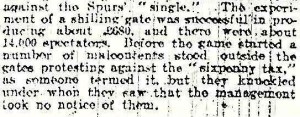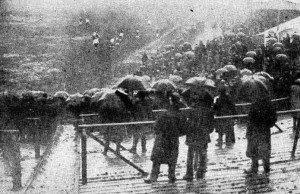By Mark Andrews – (@Royal Arsenal MRA)
and Andy Kelly – (@Gooner_AK)
The recent publicity surrounding Manchester City’s decision to charge Arsenal supporters £58 got us thinking of any non-recent historical precedents, and there are a number of early occasions when unscrupulous clubs doubled their entrance gate for the visit of Arsenal supporters. Probably the most blatant occasion was when Royal Arsenal visited Clapton in October 1891 and the opposition kept the gate at 3d for the home fans but doubled it to 6d for the Reds without any prior warning. As Arsenal won 7-0 it is doubtful too many were overly concerned by the end.
However, it is a home game that we wish to highlight with regards to fans, the clubs and raised entrance fees.
Regularly during the Plumstead period the club struggled financially to survive and without the generosity and money of George Lawrance, James Cavey and George Leavey there would have been no club for Henry Norris and William Hall to take over in 1910.
Consequently on many occasions the standard terrace charge of 6d was raised to 1 shilling and termed a fundraiser for the club. And on many occasions while the locals grumbled they stumped up the extra cash.
On Boxing Day 1911 Tottenham came to town and the Arsenal management decided to make this a shilling gate. They were somewhat unlucky as it was an exceedingly wet day which would have reduced the crowd anyway as neither terrace had any cover.
There was a demonstration against the added fee as noted in the Kentish Independent:

However, the Woolwich Gazette told a similar but more revealing and humorous story of the demonstration saying this:
“There was some discontent before the match started, some 200 persons standing outside the entrance protesting against the 1 shilling gate. However when Arsenal scored within 5 minutes of the start there was a rush for the gates and they paid up their shillings like lambs”
So what does it tell us? Not a lot other than football clubs have a “product” many want to witness. The only way to regain some element of fan control is to vote with your feet and refuse to go. But as the Woolwich Gazette clip shows, that is easier said than done.

Some of the hardy souls who watched the Boxing Day 1911 game in the rain from the vantage point of the Spion Kop, as Woolwich Arsenal beat Spurs 3-1.
—————–
The books…
- Woolwich Arsenal: The club that changed football – Arsenal’s early years
- The Crowd at Woolwich Arsenal – crowd behaviour at the early matches

Interesting that you mention the fans rushing onto the Spion Kop, that the Manor Ground was one of so many stadiums (hardly anybody ever says “stadia,” and not being British I’m not trained to say “grounds”) in the wake of the Boer War to have a stand called that. And yet, today, aside from those teams that still have them (Sheffield Wednesday and I think also Birmingham City among them), we only hear the term “Kop” in reference to Liverpool’s Anfield.
Uncle Mike,
The Spion Kop history at Plumstead is covered in the Woolwich Arsenal FC and Crowd books: http://shop.firstandbest.co.uk/product_info.php?cPath=108_122&products_id=780&osCsid=bad71c19e77b6cd4176646efdcfd867f
Also the attached clip while being mainly about Liverpool does acknowledge the Plumstead one as being the first: http://news.bbc.co.uk/sport1/hi/football/world_cup_2010/8775410.stm
Interesting article.
I wonder if anybody has an average ticket cost of going to Arsenal over the past 30 or 40 years it would be interesting to see when jumps in ticket prices occurred
Stephen,
Thanks.
Yesterday @darrenarsenal1 tweeted a ticket from 1985 and season ticket information from 1989/90. Have a look at those for more details.
Also @shewore has been doing quite abit of work on this subject.
In 1904 the average skilled wage would have been approx 30-50 Shillings per week. Unskilled would have been 20 shillings – 25 Shillings per week.